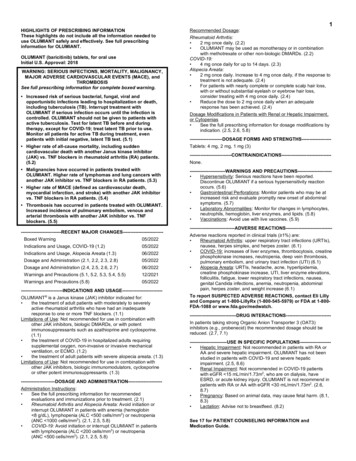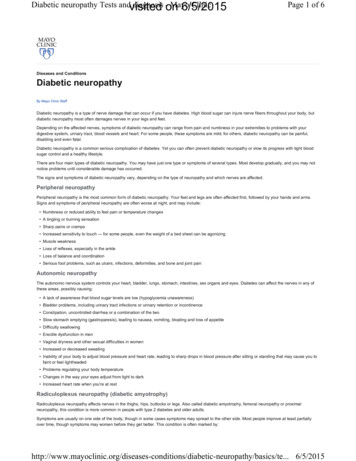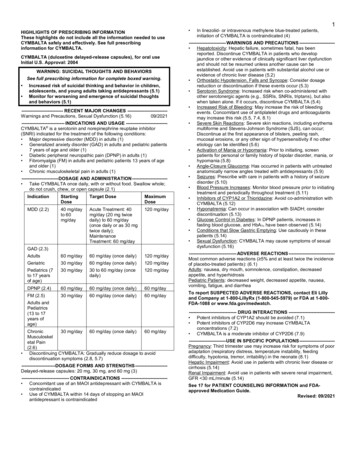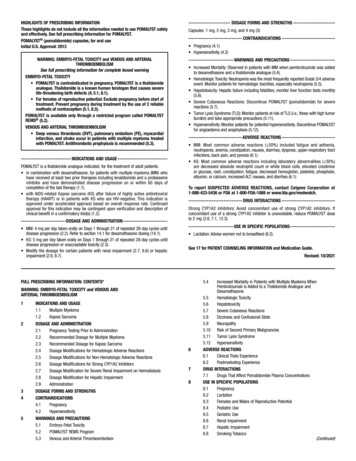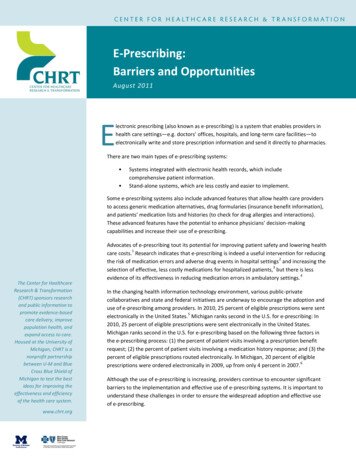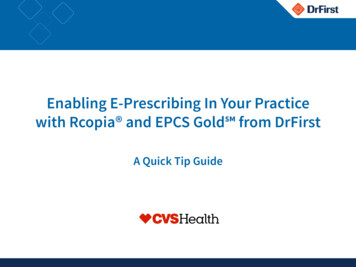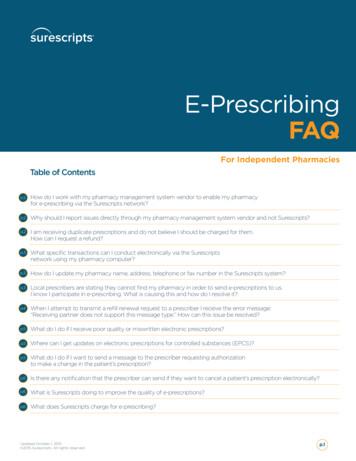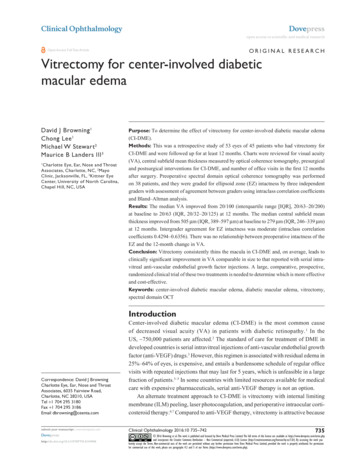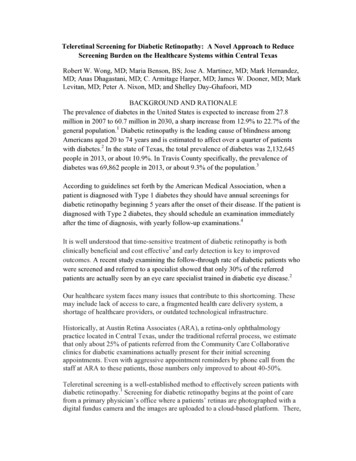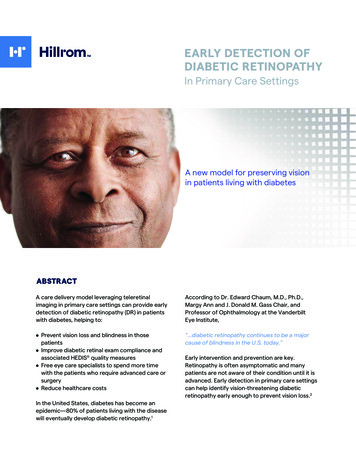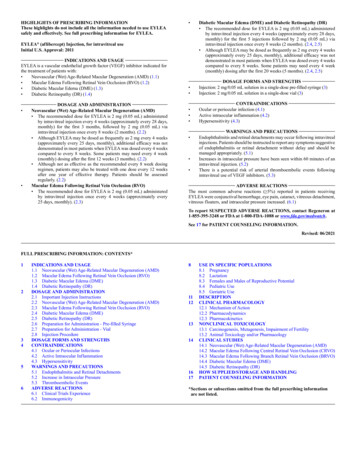
Transcription
HIGHLIGHTS OF PRESCRIBING INFORMATIONThese highlights do not include all the information needed to use EYLEAsafely and effectively. See full prescribing information for EYLEA. EYLEA (aflibercept) Injection, for intravitreal useInitial U.S. Approval: 2011INDICATIONS AND USAGEEYLEA is a vascular endothelial growth factor (VEGF) inhibitor indicated forthe treatment of patients with: Neovascular (Wet) Age-Related Macular Degeneration (AMD) (1.1) Macular Edema Following Retinal Vein Occlusion (RVO) (1.2) Diabetic Macular Edema (DME) (1.3) Diabetic Retinopathy (DR) (1.4) DOSAGE AND ADMINISTRATIONNeovascular (Wet) Age-Related Macular Degeneration (AMD) The recommended dose for EYLEA is 2 mg (0.05 mL) administeredby intravitreal injection every 4 weeks (approximately every 28 days,monthly) for the first 3 months, followed by 2 mg (0.05 mL) viaintravitreal injection once every 8 weeks (2 months). (2.2) Although EYLEA may be dosed as frequently as 2 mg every 4 weeks(approximately every 25 days, monthly), additional efficacy was notdemonstrated in most patients when EYLEA was dosed every 4 weekscompared to every 8 weeks. Some patients may need every 4 week(monthly) dosing after the first 12 weeks (3 months). (2.2) Although not as effective as the recommended every 8 week dosingregimen, patients may also be treated with one dose every 12 weeksafter one year of effective therapy. Patients should be assessedregularly. (2.2)Macular Edema Following Retinal Vein Occlusion (RVO) The recommended dose for EYLEA is 2 mg (0.05 mL) administeredby intravitreal injection once every 4 weeks (approximately every25 days, monthly). (2.3)Diabetic Macular Edema (DME) and Diabetic Retinopathy (DR) The recommended dose for EYLEA is 2 mg (0.05 mL) administeredby intravitreal injection every 4 weeks (approximately every 28 days,monthly) for the first 5 injections followed by 2 mg (0.05 mL) viaintravitreal injection once every 8 weeks (2 months). (2.4, 2.5) Although EYLEA may be dosed as frequently as 2 mg every 4 weeks(approximately every 25 days, monthly), additional efficacy was notdemonstrated in most patients when EYLEA was dosed every 4 weekscompared to every 8 weeks. Some patients may need every 4 week(monthly) dosing after the first 20 weeks (5 months). (2.4, 2.5) DOSAGE FORMS AND STRENGTHSInjection: 2 mg/0.05 mL solution in a single-dose pre-filled syringe (3)Injection: 2 mg/0.05 mL solution in a single-dose vial (3) CONTRAINDICATIONSOcular or periocular infection (4.1)Active intraocular inflammation (4.2)Hypersensitivity (4.3) WARNINGS AND PRECAUTIONSEndophthalmitis and retinal detachments may occur following intravitrealinjections. Patients should be instructed to report any symptoms suggestiveof endophthalmitis or retinal detachment without delay and should bemanaged appropriately. (5.1)Increases in intraocular pressure have been seen within 60 minutes of anintravitreal injection. (5.2)There is a potential risk of arterial thromboembolic events followingintravitreal use of VEGF inhibitors. (5.3)ADVERSE REACTIONSThe most common adverse reactions ( 5%) reported in patients receivingEYLEA were conjunctival hemorrhage, eye pain, cataract, vitreous detachment,vitreous floaters, and intraocular pressure increased. (6.1)To report SUSPECTED ADVERSE REACTIONS, contact Regeneron at1-855-395-3248 or FDA at 1-800-FDA-1088 or www.fda.gov/medwatch.See 17 for PATIENT COUNSELING INFORMATION.Revised: 06/2021FULL PRESCRIBING INFORMATION: CONTENTS*123456INDICATIONS AND USAGE1.1 Neovascular (Wet) Age-Related Macular Degeneration (AMD)1.2 Macular Edema Following Retinal Vein Occlusion (RVO)1.3 Diabetic Macular Edema (DME)1.4 Diabetic Retinopathy (DR)DOSAGE AND ADMINISTRATION2.1 Important Injection Instructions2.2 Neovascular (Wet) Age-Related Macular Degeneration (AMD)2.3 Macular Edema Following Retinal Vein Occlusion (RVO)2.4 Diabetic Macular Edema (DME)2.5 Diabetic Retinopathy (DR)2.6 Preparation for Administration - Pre-filled Syringe2.7 Preparation for Administration - Vial2.8 Injection ProcedureDOSAGE FORMS AND STRENGTHSCONTRAINDICATIONS4.1 Ocular or Periocular Infections4.2 Active Intraocular Inflammation4.3 HypersensitivityWARNINGS AND PRECAUTIONS5.1 Endophthalmitis and Retinal Detachments5.2 Increase in Intraocular Pressure5.3 Thromboembolic EventsADVERSE REACTIONS6.1 Clinical Trials Experience6.2 Immunogenicity8111213141617USE IN SPECIFIC POPULATIONS8.1 Pregnancy8.2 Lactation8.3 Females and Males of Reproductive Potential8.4 Pediatric Use8.5 Geriatric UseDESCRIPTIONCLINICAL PHARMACOLOGY12.1 Mechanism of Action12.2 Pharmacodynamics12.3 PharmacokineticsNONCLINICAL TOXICOLOGY13.1 Carcinogenesis, Mutagenesis, Impairment of Fertility13.2 Animal Toxicology and/or PharmacologyCLINICAL STUDIES14.1 Neovascular (Wet) Age-Related Macular Degeneration (AMD)14.2 Macular Edema Following Central Retinal Vein Occlusion (CRVO)14.3 Macular Edema Following Branch Retinal Vein Occlusion (BRVO)14.4 Diabetic Macular Edema (DME)14.5 Diabetic Retinopathy (DR)HOW SUPPLIED/STORAGE AND HANDLINGPATIENT COUNSELING INFORMATION* Sections or subsections omitted from the full prescribing informationare not listed.
FULL PRESCRIBING INFORMATION1INDICATIONS AND USAGEEYLEA is indicated for the treatment of:1.1 Neovascular (Wet) Age-Related Macular Degeneration (AMD)1.2 Macular Edema Following Retinal Vein Occlusion (RVO)1.3 Diabetic Macular Edema (DME)1.4 Diabetic Retinopathy (DR)2DOSAGE AND ADMINISTRATION2.1 Important Injection InstructionsFor ophthalmic intravitreal injection. EYLEA must only be administered by aqualified physician.Pre-filled Syringe: A 30-gauge ½-inch sterile injection needle is needed butnot provided.Vial: A 5-micron sterile filter needle (19-gauge 1½-inch), a 1-mL Luer locksyringe and a 30-gauge ½-inch sterile injection needle are needed.EYLEA is available packaged as follows: Pre-filled Syringe Vial Kit with Injection Components (filter needle, syringe, injection needle)[see How Supplied/Storage and Handling (16)].2.2 Neovascular (Wet) Age-Related Macular Degeneration (AMD)The recommended dose for EYLEA is 2 mg (0.05 mL or 50 microliters)administered by intravitreal injection every 4 weeks (approximately every28 days, monthly) for the first 12 weeks (3 months), followed by 2 mg(0.05 mL) via intravitreal injection once every 8 weeks (2 months). AlthoughEYLEA may be dosed as frequently as 2 mg every 4 weeks (approximately every25 days, monthly), additional efficacy was not demonstrated in most patientswhen EYLEA was dosed every 4 weeks compared to every 8 weeks [seeClinical Studies (14.1)]. Some patients may need every 4 week (monthly)dosing after the first 12 weeks (3 months). Although not as effective as therecommended every 8 week dosing regimen, patients may also be treated withone dose every 12 weeks after one year of effective therapy. Patients should beassessed regularly.2.3 Macular Edema Following Retinal Vein Occlusion (RVO)The recommended dose for EYLEA is 2 mg (0.05 mL or 50 microliters)administered by intravitreal injection once every 4 weeks (approximately every25 days, monthly) [see Clinical Studies (14.2), (14.3)].2.4 Diabetic Macular Edema (DME)The recommended dose for EYLEA is 2 mg (0.05 mL or 50 microliters)administered by intravitreal injection every 4 weeks (approximately every28 days, monthly) for the first 5 injections, followed by 2 mg (0.05 mL) viaintravitreal injection once every 8 weeks (2 months). Although EYLEA maybe dosed as frequently as 2 mg every 4 weeks (approximately every 25 days,monthly), additional efficacy was not demonstrated in most patients whenEYLEA was dosed every 4 weeks compared to every 8 weeks [see ClinicalStudies (14.4)]. Some patients may need every 4 week (monthly) dosing afterthe first 20 weeks (5 months).2.5 Diabetic Retinopathy (DR)The recommended dose for EYLEA is 2 mg (0.05 mL or 50 microliters)administered by intravitreal injection every 4 weeks (approximately every28 days, monthly) for the first 5 injections, followed by 2 mg (0.05 mL) viaintravitreal injection once every 8 weeks (2 months). Although EYLEA maybe dosed as frequently as 2 mg every 4 weeks (approximately every 25 days,monthly), additional efficacy was not demonstrated in most patients whenEYLEA was dosed every 4 weeks compared to every 8 weeks [see ClinicalStudies (14.5)]. Some patients may need every 4 week (monthly) dosing afterthe first 20 weeks (5 months).2.6 Preparation for Administration - Pre-filled SyringeThe EYLEA pre-filled glass syringe is sterile and for single use only. It shouldbe inspected visually prior to administration. Do not use if particulates,cloudiness, or discoloration are visible, or if the package is open or damaged.The appearance of the syringe cap on the pre-filled syringe may vary (forexample, color and design). Do not use if any part of the pre-filled syringe isdamaged or if the syringe cap is detached from the Luer lock.The intravitreal injection should be performed with a 30-gauge x ½-inchinjection needle (not provided).The pre-filled syringe contains more than the recommended dose of 2 mgaflibercept (equivalent to 50 microliters). The excess volume must bediscarded prior to the administration.PRE-FILLED SYRINGE DESCRIPTION – Figure 1:Syringe CapLuer Lock0.05 mL Dosing LinePlungerFinger GripPlunger RodUse aseptic technique to carry out the following steps:1. PREPAREWhen ready to administer EYLEA, open the carton and remove sterilized blisterpack. Carefully peel open the sterilized blister pack ensuring the sterility of itscontents. Keep the syringe in the sterile tray until you are ready for assembly.2. REMOVE SYRINGEUsing aseptic technique, remove the syringe from the sterilized blister pack.3. TWIST OFF SYRINGE CAPTwist off the syringe cap by holding the syringe in one hand and the syringe capwith the thumb and forefinger of the other hand (see Figure 2).Note: To avoid compromising the sterility of the product, do not pull back onthe plunger.Figure 2:TWIST!4. ATTACH NEEDLEUsing aseptic technique, firmly twist a 30-gauge x ½-inch injection needle ontothe Luer lock syringe tip (see Figure 3).Figure 3:Note: When ready to administer EYLEA, remove the plastic needle shield fromthe needle.5. DISLODGE AIR BUBBLESHolding the syringe with the needle pointing up, check the syringe for bubbles.If there are bubbles, gently tap the syringe with your finger until the bubblesrise to the top (see Figure 4).Figure 4:TAP!
Figure 5a:Figure 5b:Plunger DomeSolution afterexpelling air bubblesand excess drug5. Using aseptic technique withdraw all of the EYLEA vial contents into thesyringe, keeping the vial in an upright position, slightly inclined to easecomplete withdrawal. To deter the introduction of air, ensure the bevelof the filter needle is submerged into the liquid. Continue to tilt the vialduring withdrawal keeping the bevel of the filter needle submerged in theliquid (see Figure 9a and Figure 9b).Figure 9a:Figure 9b:0.91ml6. EXPEL AIR AND SET THE DOSETo eliminate all bubbles and to expel excess drug, slowly depress the plungerrod to align the plunger dome edge (see Figure 5a) with the black dosing lineon the syringe (equivalent to 50 microliters) (see Figure rDomeEdge0.20.30.4DosingLineSolution0.50.6Air BubblePlungerDomeEdge0.3Needle BevelPointing DownSolution7. The pre-filled syringe is for single use only. After injection any unusedproduct must be discarded.0.110.220.9l1m0.70.8Figure 6:Figure 10:0.50.62.7 Preparation for Administration - VialEYLEA should be inspected visually prior to administration. If particulates,cloudiness, or discoloration are visible, the vial must not be used.The glass vial is for single use only.Use aseptic technique to carry out the following preparation steps:Prepare for intravitreal injection with the following medical devices for singleuse: a 5-micron sterile filter needle (19-gauge 1½-inch) a 1-mL sterile Luer lock syringe (with marking to measure 0.05 mL) a sterile injection needle (30-gauge ½-inch)1.Remove the protective plastic cap from the vial (see Figure 6).6. Ensure that the plunger rod is drawn sufficiently back when emptying thevial in order to completely empty the filter needle.7. Remove the filter needle from the syringe and properly dispose of thefilter needle. Note: Filter needle is not to be used for intravitreal injection.8. Remove the 30-gauge ½-inch injection needle from its packaging andattach the injection needle to the syringe by firmly twisting the injectionneedle onto the Luer lock syringe tip (see Figure 10).9. When ready to administer EYLEA, remove the plastic needle shield fromthe needle.10. Holding the syringe with the needle pointing up, check the syringe forbubbles. If there are bubbles, gently tap the syringe with your finger untilthe bubbles rise to the top (see Figure 11).Figure 11:2.Clean the top of the vial with an alcohol wipe (see Figure 7).Figure 7:0.1020.20.30.4040.50.60.70.80.91ml11. To eliminate all of the bubbles and to expel excess drug, SLOWLYdepress the plunger so that the plunger tip aligns with the line that marks0.05 mL on the syringe (see Figure 12a and Figure 12b).3. Remove the 19-gauge 1½-inch, 5-micron, filter needle and the 1-mLsyringe from their packaging. Attach the filter needle to the syringe bytwisting it onto the Luer lock syringe tip (see Figure 8).Figure 12a:Figure 12b:Solution afterexpelling air bubblesand excess drugDosing Line for 0.05 mlFigure 8:0.80.9l1m0.10.20.30.40.50.60.74. Push the filter needle into the center of the vial stopper until the needle iscompletely inserted into the vial and the tip touches the bottom or bottomedge of the vial.0.10.2020.30.10.2020.30.40.100.22Flat PlungerEdge
2.8 Injection ProcedureThe intravitreal injection procedure should be carried out under controlledaseptic conditions, which include surgical hand disinfection and the use ofsterile gloves, a sterile drape, and a sterile eyelid speculum (or equivalent).Adequate anesthesia and a topical broad–spectrum microbicide should be givenprior to the injection.Note for the pre-filled syringe: A small residual volume may remain in thesyringe after a full dose has been injected. This is normal.Immediately following the intravitreal injection, patients should be monitoredfor elevation in intraocular pressure. Appropriate monitoring may consist of acheck for perfusion of the optic nerve head or tonometry. If required, a sterileparacentesis needle should be available.Following intravitreal injection, patients should be instructed to report anysymptoms suggestive of endophthalmitis or retinal detachment (e.g., eye pain,redness of the eye, photophobia, blurring of vision) without delay [see PatientCounseling Information (17)].Each sterile, pre-filled syringe or vial should only be used for the treatment ofa single eye. If the contralateral eye requires treatment, a new sterile, pre-filledsyringe or vial should be used and the sterile field, syringe, gloves, drapes,eyelid speculum, filter, and injection needles should be changed before EYLEAis administered to the other eye.After injection, any unused product must be discarded.3DOSAGE FORMS AND STRENGTHSEYLEA is a clear, colorless to pale yellow solution available as: Injection: 2 mg/0.05 mL in a single-dose pre-filled glass syringe Injection: 2 mg/0.05 mL in a single-dose glass vial4CONTRAINDICATIONS4.1 Ocular or Periocular InfectionsEYLEA is contraindicated in patients with ocular or periocular infections.4.2 Active Intraocular InflammationEYLEA is contraindicated in patients with active intraocular inflammation.4.3 HypersensitivityEYLEA is contraindicated in patients with known hypersensitivity to afliberceptor any of the excipients in EYLEA. Hypersensitivity reactions may manifest asrash, pruritus, urticaria, severe anaphylactic/anaphylactoid reactions, or severeintraocular inflammation.5WARNINGS AND PRECAUTIONS5.1 Endophthalmitis and Retinal DetachmentsIntravitreal injections, including those with EYLEA, have been associatedwith endophthalmitis and retinal detachments [see Adverse Reactions (6.1)].Proper aseptic injection technique must always be used when administeringEYLEA. Patients should be instructed to report any symptoms suggestive ofendophthalmitis or retinal detachment without delay and should be managedappropriately [see Dosage and Administration (2.8) and Patient CounselingInformation (17)].5.2 Increase in Intraocular PressureAcute increases in intraocular pressure have been seen within 60 minutes ofintravitreal injection, including with EYLEA [see Adverse Reactions (6.1)].Sustained increases in intraocular pressure have also been reported afterrepeated intravitreal dosing with vascular endothelial growth factor (VEGF)inhibitors. Intraocular pressure and the perfusion of the optic nerve head shouldbe monitored and managed appropriately [see Dosage and Administration(2.8)].5.3 Thromboembolic EventsThere is a potential risk of arterial thromboembolic events (ATEs) followingintravitreal use of VEGF inhibitors, including EYLEA. ATEs are defined asnonfatal stroke, nonfatal myocardial infarction, or vascular death (includingdeaths of unknown cause). The incidence of reported thromboembolic eventsin wet AMD studies during the first year was 1.8% (32 out of 1824) in thecombined group of patients treated with EYLEA compared with 1.5% (9 outof 595) in patients treated with ranibizumab; through 96 weeks, the incidencewas 3.3% (60 out of 1824) in the EYLEA group compared with 3.2% (19 out of595) in the ranibizumab group. The incidence in the DME studies from baselineto week 52 was 3.3% (19 out of 578) in the combined group of patients treatedwith EYLEA compared with 2.8% (8 out of 287) in the control group; frombaseline to week 100, the incidence was 6.4% (37 out of 578) in the combinedgroup of patients treated with EYLEA compared with 4.2% (12 out of 287)in the control group. There were no reported thromboembolic events in thepatients treated with EYLEA in the first six months of the RVO studies.6ADVERSE REACTIONSThe following potentially serious adverse reactions are described elsewhere inthe labeling: Hypersensitivity [see Contraindications (4.3)] Endophthalmitis and retinal detachments [see Warnings and Precautions(5.1)] Increase in intraocular pressure [see Warnings and Precautions (5.2)] Thromboembolic events [see Warnings and Precautions (5.3)]6.1 Clinical Trials ExperienceBecause clinical trials are conducted under widely varying conditions, adversereaction rates observed in the clinical trials of a drug cannot be directlycompared to rates in other clinical trials of the same or another drug and maynot reflect the rates observed in practice.A total of 2980 patients treated with EYLEA constituted the safety populationin eight phase 3 studies. Among those, 2379 patients were treated with therecommended dose of 2 mg. Serious adverse reactions related to the injectionprocedure have occurred in 0.1% of intravitreal injections with EYLEAincluding endophthalmitis and retinal detachment. The most common adversereactions ( 5%) reported in patients receiving EYLEA were conjunctivalhemorrhage, eye pain, cataract, vitreous detachment, vitreous floaters, andintraocular pressure increased.Neovascular (Wet) Age-Related Macular Degeneration (AMD)The data described below reflect exposure to EYLEA in 1824 patients with wetAMD, including 1223 patients treated with the 2-mg dose, in 2 double-masked,controlled clinical studies (VIEW1 and VIEW2) for 24 months (with activecontrol in year 1) [see Clinical Studies (14.1)].Safety data observed in the EYLEA group in a 52-week, double-masked, Phase 2study were consistent with these results.Table 1:Most Common Adverse Reactions ( 1%) in Wet AMD StudiesAdverseReactionsConjunctivalhemorrhageEye painCataractVitreousdetachmentVitreous aCornealepitheliumdefectDetachmentof the retinalpigmentepitheliumInjection sitepainForeign bodysensation in eyesLacrimationincreasedVision blurredIntraocularinflammationRetinal pigmentepithelium tearInjection sitehemorrhageEyelid edemaCorneal edemaRetinaldetachmentBaseline to Week 52Baseline to Week 96EYLEA Active Control EYLEAControl(N 1824) (ranibizumab) (N 1824) (ranibizumab)(N 595)(N %4%3%1%4%2%2%2%2%3%4%3%3%4%2%1%2%2%1%2%2%2%1%1% 1%2%1% 1%2%1%1%3%1%1%Less common serious adverse reactions reported in 1% of the patients treatedwith EYLEA were hypersensitivity, retinal tear, and endophthalmitis.Macular Edema Following Retinal Vein Occlusion (RVO)The data described below reflect 6 months exposure to EYLEA with a monthly2 mg dose in 218 patients following central retinal vein occlusion (CRVO) in2 clinical studies (COPERNICUS and GALILEO) and 91 patients followingbranch retinal vein occlusion (BRVO) in one clinical study (VIBRANT) [seeClinical Studies (14.2), (14.3)].
Table 2:Most Common Adverse Reactions ( 1%) in RVO StudiesAdverse ReactionsEye painConjunctivalhemorrhageIntraocular pressureincreasedCorneal epitheliumdefectVitreous floatersOcular hyperemiaForeign body sensationin eyesVitreous detachmentLacrimation increasedInjection site painVision blurredIntraocular inflammationCataractEyelid edemaCRVOEYLEAControl(N 218)(N 142)13%5%12%11%BRVOEYLEAControl(N 91)(N 0%3%3%3%1%1% 1% 1%4%4%1% 1%1%1%1%2%3%1%1%0%5%1%0%0%0%1%0%0%0%Less common adverse reactions reported in 1% of the patients treated withEYLEA in the CRVO studies were corneal edema, retinal tear, hypersensitivity,and endophthalmitis.Diabetic Macular Edema (DME) and Diabetic Retinopathy (DR)The data described below reflect exposure to EYLEA in 578 patients with DMEtreated with the 2-mg dose in 2 double-masked, controlled clinical studies(VIVID and VISTA) from baseline to week 52 and from baseline to week 100[see Clinical Studies (14.4)].Table 3:Most Common Adverse Reactions ( 1%) in DME StudiesAdverseReactionsConjunctivalhemorrhageEye painCataractVitreous floatersCornealepithelium defectIntraocularpressureincreasedOcular hyperemiaVitreousdetachmentForeign bodysensation in eyesLacrimationincreasedVision blurredIntraocularinflammationInjection site painEyelid edemaBaseline to Week 52EYLEAControl(N 578)(N 287)28%17%Baseline to Week 100EYLEAControl(N 578)(N %5%5%3%6%3%5%8%6%6%3%3%3%3%3%2%4%2%2%2%2% 1%3%3%4%1%2% 1% 1%1%2%2% 1%1%Less common adverse reactions reported in 1% of the patients treated withEYLEA were hypersensitivity, retinal detachment, retinal tear, corneal edema,and injection site hemorrhage.Safety data observed in 269 patients with nonproliferative diabetic retinopathy(NPDR) through week 52 in the PANORAMA trial were consistent with thoseseen in the phase 3 VIVID and VISTA trials (see Table 3 above).6.2 ImmunogenicityAs with all therapeutic proteins, there is a potential for an immune response inpatients treated with EYLEA. The immunogenicity of EYLEA was evaluatedin serum samples. The immunogenicity data reflect the percentage of patientswhose test results were considered positive for antibodies to EYLEA inimmunoassays. The detection of an immune response is highly dependenton the sensitivity and specificity of the assays used, sample handling, timingof sample collection, concomitant medications, and underlying disease. Forthese reasons, comparison of the incidence of antibodies to EYLEA with theincidence of antibodies to other products may be misleading.In the wet AMD, RVO, and DME studies, the pre-treatment incidence ofimmunoreactivity to EYLEA was approximately 1% to 3% across treatmentgroups. After dosing with EYLEA for 24-100 weeks, antibodies to EYLEA weredetected in a similar percentage range of patients. There were no differences inefficacy or safety between patients with or without immunoreactivity.8USE IN SPECIFIC POPULATIONS8.1 PregnancyRisk SummaryAdequate and well-controlled studies with EYLEA have not been conducted inpregnant women. Aflibercept produced adverse embryofetal effects in rabbits,including external, visceral, and skeletal malformations. A fetal No ObservedAdverse Effect Level (NOAEL) was not identified. At the lowest dose shownto produce adverse embryofetal effects, systemic exposures (based on AUC forfree aflibercept) were approximately 6 times higher than AUC values observedin humans after a single intravitreal treatment at the recommended clinical dose[see Animal Data].Animal reproduction studies are not always predictive of human response, andit is not known whether EYLEA can cause fetal harm when administered to apregnant woman. Based on the anti-VEGF mechanism of action for aflibercept[see Clinical Pharmacology (12.1)], treatment with EYLEA may pose a risk tohuman embryofetal development. EYLEA should be used during pregnancyonly if the potential benefit justifies the potential risk to the fetus.All pregnancies have a background risk of birth defect, loss, or other adverseoutcomes. The background risk of major birth defects and miscarriage for theindicated population is unknown. In the U.S. general population, the estimatedbackground risk of major birth defects and miscarriage in clinically recognizedpregnancies is 2-4% and 15-20%, respectively.DataAnimal DataIn two embryofetal development studies, aflibercept produced adverseembryofetal effects when administered every three days during organogenesisto pregnant rabbits at intravenous doses 3 mg per kg, or every six days duringorganogenesis at subcutaneous doses 0.1 mg per kg.Adverse embryofetal effects included increased incidences of postimplantationloss and fetal malformations, including anasarca, umbilical hernia,diaphragmatic hernia, gastroschisis, cleft palate, ectrodactyly, intestinal atresia,spina bifida, encephalomeningocele, heart and major vessel defects, andskeletal malformations (fused vertebrae, sternebrae, and ribs; supernumeraryvertebral arches and ribs; and incomplete ossification). The maternal NoObserved Adverse Effect Level (NOAEL) in these studies was 3 mg per kg.Aflibercept produced fetal malformations at all doses assessed in rabbits and thefetal NOAEL was not identified. At the lowest dose shown to produce adverseembryofetal effects in rabbits (0.1 mg per kg), systemic exposure (AUC) of freeaflibercept was approximately 6 times higher than systemic exposure (AUC)observed in humans after a single intravitreal dose of 2 mg.8.2 LactationRisk SummaryThere is no information regarding the presence of aflibercept in human milk,the effects of the drug on the breastfed infant, or the effects of the drug on milkproduction/excretion. Because many drugs are excreted in human milk, andbecause the potential for absorption and harm to infant growth and developmentexists, EYLEA is not recommended during breastfeeding.The developmental and health benefits of breastfeeding should be consideredalong with the mother’s clinical need for EYLEA and any potential adverseeffects on the breastfed child from EYLEA.8.3 Females and Males of Reproductive PotentialContraceptionFemales of reproductive potential are advised to use effective contraceptionprior to the initial dose, during treatment, and for at least 3 months after the lastintravitreal injection of EYLEA.InfertilityThere are no data regarding the effects of EYLEA on human fertility. Afliberceptadversely affected female and male reproductive systems in cynomolgusmonkeys when administered by intravenous injection at a dose approximately1500 times higher than the systemic level observed humans with an intravitrealdose of 2 mg. A No Observed Adverse Effect Level (NOAEL) was notidentified. These findings were reversible within 20 weeks after cessation oftreatment [see Nonclinical Toxicology (13.1)].8.4 Pediatric UseThe safety and effectiveness of EYLEA in pediatric patients have not beenestablished.
8.5 Geriatric UseIn the clinical studies, approximately 76% (2049/2701) of patients randomizedto treatment with EYLEA were 65 years of age and approximately 46%(1250/2701) were 75 years of age. No significant differences in efficacy orsafety were seen with increasing age in these studies.11 DESCRIPTIONAflibercept is a recombinant fusion protein consisting of portions of humanVEGF receptors 1 and 2 extracellular domains fused to the Fc portion of humanIgG1 formulated as an iso-osmotic solution for intravitreal administration.Aflibercept is a dimeric glycoprotein with a protein molecular weight of97 kilodaltons (kDa) and contains glycosylation, constituting an additional 15%of the total molecular mass, resulting in a total molecular weight of 115 kDa.Aflibercept is produced in recombinant Chinese hamster ovary (CHO) cells.EYLEA (aflibercept) Injection is a sterile, clear, and colorless to pale yellowsolution. EYLEA is supplied as a preservative-free, sterile, aqueous solution forintravitreal injection in a single-dose pre-filled glass syringe or a single-doseglass vial designed to deliver 0.05 mL (50 microliters) of solution containing2 mg of aflibercept in 10 mM sodium phosphate, 40 mM sodium chloride,0.03% polysorbate 20, and 5% sucrose, with a pH of 6.2.12 CLINICAL PHARMACOLOGY12.1 Mechanism of ActionVascular endothelial growth factor-A (VEGF-A) and placental growth factor(PlGF) are members of the VEGF family of angiogenic factors that can act asmitogenic, chemotactic, and vascular permeability factors for endothelial cells.VEGF acts via two receptor tyrosine kinases, VEGFR-1 and VEGFR-2, presenton the surface of endothelial cells. PlGF binds only to VEGFR-1, which is alsopresent on the surface of leucocytes. Activation of these receptors by VEGF-Acan result in neovascularization and vascular permeability.Aflibercept acts as a soluble decoy receptor that binds VEGF-A and PlGF, andthereby can inhibit the binding and activation of these cognate VEGF receptors.12.2 PharmacodynamicsNeovascular (We
FULL PRESCRIBING INFORMATION 1 INDICATIONS AND USAGE EYLEA is indicated for the treatment of: 1.1 0.05 mL Dosing LineNeovascular (Wet) Age-Related Macular Degeneration (AMD)

